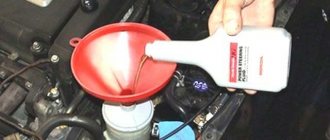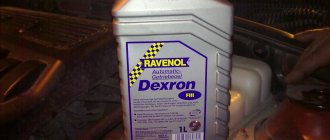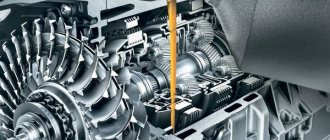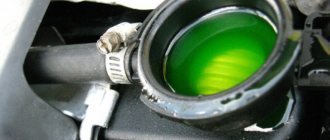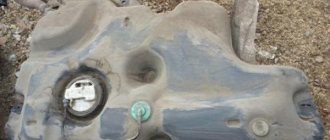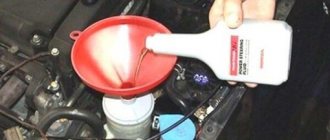To drive a Renault Logan without power steering, drivers have to make a lot of effort when turning the steering wheel, which causes a lot of inconvenience while driving. This inconvenience can be compensated for by installing a hydraulic power steering , during routine maintenance of which only fluid replacement is required.
From the material you will learn at what interval and after the appearance of what signs the oil in the Renault Logan power steering is changed, what nuances you need to know about the recommended types of lubricants, and how to service the unit yourself.
Changing power steering oil in Renault Logan
To make it easier to operate a car, engineers have come up with such a useful device as power steering. A hydraulic booster is installed on some cars. It allows you to turn the steering wheel with minimal effort from the driver. However, do not forget that, like any other unit, power steering requires maintenance. The basic procedure is to change the Renault Logan power steering oil. Drivers can do it themselves in a garage. You will find all the necessary information in this article.
When should you change the oil?
The oil change in the power steering, according to the manufacturer's recommendations, should be carried out every 2 years or 40 thousand kilometers. The frequency of replacement varies depending on the age of the vehicle. Thus, models of 2006, 2007, 2008, 2009, 2010 require more frequent maintenance and replacement of lubricant. For older cars, the optimal mileage will be 25–30 thousand kilometers. As for the more “fresh” models of 2011, 2012, 2013, 2014, 2015, 2016, 2022, these cars are subject to the first replacement at around 40 thousand kilometers. And when buying a used car, experts advise immediately filling the power steering with new lubricant.
If you ignore the manufacturer's recommendations, the responsiveness of the steering wheel will deteriorate over time, and later malfunctions will occur in the entire steering system of the car.
Problems may arise before the recommended fluid change period has expired. For example, when the lubricant in the reservoir has a rich dark color, this indicates the presence of metal particles in it. In addition, this oil smells burnt. Such fluid must be replaced immediately. Also, the lubricant should be changed when the vehicle has not been used for a long time. The reason is the occurrence of condensate in the hydraulic power steering system, which, when mixed with liquid, forms an emulsion and contributes to the loss of all properties of the power steering lubricant.
How to choose a pump and change the belt?
The power steering belt also needs to be replaced. The automaker does not give an exact answer to the question of how long it needs to be changed, but experienced drivers recommend a figure of 100–150 thousand kilometers. In addition, the belt and oil are replaced if the power steering starts to hum. The occurrence of extraneous noise in the operation of the car always indicates a malfunction.
In some cases, the problem lies in the pump, and a more rational solution would be to purchase a new part. When choosing a pump, you need to take into account the manufacturer and article number to avoid counterfeiting. For example, for Renault Logan, pumps with codes 491100699R and 7700435692 from Francecar are recommended. After replacing the part and adding new oil, the extraneous sounds in the power steering will disappear.
To replace the belt you will need a key “14”.
The operation is carried out in five steps:
- The fastening elements of the power steering pump are loosened.
- The adjusting bolt is unscrewed, the specification of which is the level of belt tension.
- When the belt is loosened, you can begin to remove it from the pulleys of the power steering pump, air conditioning and crankshaft of the vehicle.
- Installation is carried out in reverse order.
- Finally, the tension level of the belt, which is located in the power steering pump, is adjusted.
After replacing the pump or belt, the power steering continues to function normally, and the oil pressure in the power steering remains at a stable level necessary for the operation of the entire power steering system.
When to change the power steering oil in Renault Logan?
The manufacturer's recommended schedule for changing power steering oil in Renault Logan is every 40 thousand kilometers or once every two years. But at least once a month you need to check the fluid level in order to notice warning signs in time:
- sediment in the tank or on its lid, the appearance of metal shavings in the oil;
- decreased oil level in the power steering reservoir: you need to find the leak and restore the integrity of the system;
- Renault Logan power steering fluid has lost its original shade, becoming too dark;
- the appearance of an unpleasant burnt odor.
In this case, the power steering oil is not simply replaced, it is necessary to diagnose the entire system and eliminate malfunctions.
In addition to ELFMatic G3, the manufacturer allows the use of other oils from well-known manufacturers: Liqui Moly ATF 1100, Castrol ATF D2 or D3, Mobil ATF 220 or 320. All of them have high performance and will ensure normal operation of the pump and the entire power steering system.
Video: Replacing power steering fluid for Renault Logan, Sandero, Duster, Largus
Is it possible to mix
As an alternative, a partial power steering oil change can be used. In this case, it is enough to pump out the old oil from the tank and fill the full tank with new composition. Then there will inevitably be a mixing of new oil and residues that are in the pipes and the power steering itself.
The main rule is that synthetic oil should not be mixed with mineral oil. This can cause foaming and other chemical reactions, which will eventually completely destroy the power steering. Conventionally, three mixing groups are distinguished:
- conditionally mixed - these are mineral compositions of red and yellow color;
- mineral compositions of green flowers (similar in parameters);
- synthetic compounds – defined.
Currently reading: Front headlight on Dacia Logan in Kyiv. Compare prices, buy consumer goods on the Prom.ua marketplace
You also have to resort to mixing during leaks, until it is eliminated. We first recommend that you study the issue of compatibility of two specific formulations on specialized forums or with an official dealer.
How to choose power steering fluid Renault Logan
As is the case with other components, mineral, semi-synthetic and synthetic fluids can be found for power steering. Naturally, mineral oils will be the most affordable, but they lose their properties faster, “stick” more in the cold, etc. Synthetics are noticeably more expensive, but have a longer lifespan and are better suited for all-season use.
For this reason, it is important to pay attention to tolerances and specifications. To understand what kind of oil to fill in the Renault Logan power steering, you need to study the properties of the original composition. Elf Renault Matic D2 oil is filled at the factory. At the same time, you can cast analogues on a synthetic and semi-synthetic base (standard D2 ATF, PSF is also suitable). You can also highlight Elf Renault Matic G3, Mobil ATF 220 or 320, Liqui Moly ATF 1100.
Types of oils
Before we talk about choosing a specific brand of oil, let's find out what types of this working fluid exist in principle. Manufacturers produce both special formulations that are intended for use in power steering systems and fluids compatible with gearboxes. There are two main types:
- Mineral. These compounds are used most often in systems with a large number of rubber parts (seals and the like). When exposed to high and low temperatures, rubber loses its quality. To prevent this, use mineral oil. It is gentle on rubber components and has a low cost. There are also a number of disadvantages: high viscosity, tendency to foam and short service life.
- Synthetic. Some of these oils have a destructive effect on rubber parts. Some manufacturers have improved the composition with silicone, which neutralized this effect. Synthetics have low viscosity, are durable, retain their qualities over a wide temperature range and are distinguished by better lubricating, anti-corrosion, and foam-suppressing properties. Naturally, you have to pay for this.
There is also a conditional classification of liquids by color. This is additional information. It is not absolute, since individual manufacturers may use dyes in their products. Most often, of course, the following colors are sold on the market:
- Red. Considered to be of the highest quality. They are made on the basis of synthetics. Similar compositions are also often used in automatic transmissions, but have a fairly narrow application specification.
- Yellow. As a rule, these are mineral oils, which are often used for gearboxes. An example is the products of the German company Daimler.
- Green. It is considered universal, but is used only in mechanics or only as a fluid for power steering. It has high viscosity. The base can be either mineral or synthetic.
Now you can visually determine the type of oil by color. Before pouring anything, be sure to study the specification, since the color of the liquid is not yet a 100% indicator.
What oil to fill in Renault
Of course, each Renault owner can decide for himself which oil he considers most suitable for his car, but we still advise you to follow the recommendations of the manufacturer of your car. The RENAULT concern recommends using ELF oil , so this is what needs to be poured. It is only advisable to buy oil from an organization known to you in order to accurately fill it with real ELF, since today there are a lot of fakes, especially in plastic cans.
We purchase oil in metal barrels directly from the manufacturer and guarantee that your engine and gearbox will contain exactly the oil that Renault recommends . From our experience of long-term maintenance of Renault cars that work in taxis, and these are engine mileages of about 400-500 t.km , we can say that
The manufacturer's recommendations are not unfounded.
Regular oil changes to those recommended by the manufacturer made it possible to avoid engine repairs even at such high mileage.
Whether or not to flush the engine before changing the oil is also a purely personal matter. But we definitely recommend flushing, and using MANNOL , since again, from our experience, this flushing has saved more than one already “dying” engine from repair and has significantly increased its service life . But it’s still up to you to decide.
Below it is written which oil should be poured into the engine, gearbox, power steering, gearbox and transfer case. These recommendations apply to the entire Renault model range, of course, with the exception of the gearbox and transfer case, which not everyone has.
During an oil change, we carry out diagnostics of the vehicle's chassis at your request, this is free. And what’s more, during certain periods of the year, you can change the engine oil for free in our service. (You can view free replacement periods and the cost of oil with filter here.)
When is it official to change?
40,000 kilometers or no more than 2 years - regulations for replacing power steering fluid
The regulations from the official dealer state that the oil that is poured directly from the factory into Renault Logan is designed for a mileage of 40,000 kilometers or no more than 2 years of operation, whichever comes first.
In what cases may it be necessary to replace it ahead of schedule?
However, it is necessary to monitor the condition of the oil in the power steering expansion tank at every stage of vehicle maintenance. To change the oil outside the stipulated time frame, the following will apply:
- Metal trash
- Dark liquid color
- Unpleasant smell
For comparison, a drop of new oil (circled in blue) and a couple of drops of drained power steering oil
And also, for immediate repair and inspection of the entire steering system, there will be an insufficient level of power steering oil in the expansion tank, because if this malfunction occurs, the oil temperature will quickly increase, and the mechanism itself will fail.
Advice! If, while driving a car, you feel like the steering wheel has become difficult to turn, and it has become like oak, noise or an extraneous hum has appeared. Go to the specialist immediately. Because a breakdown of the power steering can result in, at best, a breakdown of the steering mechanism, and in the worst case, it can cause a traffic accident.
Underwater rocks
Changing the oil, pump or belt in the power steering of a car yourself carries a number of risks:
- When disassembling the system, there is a high probability of damage to the main components and mechanisms. Before you climb under the hood of a car yourself, it’s worth watching training videos and photos on changing the power steering oil.
- The cost of the original pump, belt or oil should not be prohibitively low. So, if Mobile or Elf oils are sold at a low price, then most likely they are counterfeit. The use of low-quality liquids will lead to failure of the seals and the pump itself as a whole, which will cause condensation to accumulate on the parts. “Fogged” elements are more susceptible to failure, which will lead to unstable operation and breakdown of the vehicle’s power steering. Buying a non-original pump will also lead to failure. In some cases, a fake pump can be easily identified - its size will not correspond to the niche in which it should be installed.
- To speed up the process of “flushing” the power steering, you can turn on the car’s engine. It is important to prevent air leaks in the system pump - this will lead to breakdown. To prevent air from entering the expansion tank, oil must be constantly added.
- When replacing parts, you should remove the injection compressor with extreme caution. Hoses and pipes can “stick”, and if disconnected carelessly, there is a high risk of leaving the hose ring at the connection point.
How do you know when it’s time to change the oil in your amplifier?
The need to replace the working fluid in the amplifier may be due to the following symptoms:
- The appearance of sediment in the expansion tank, as well as wear products, in particular metal shavings.
- Insufficient level of consumables in the tank. In this case, you must first determine the location of the leak and the cause of the malfunction, only after that the substance is added or replaced.
- The oil in the reservoir has acquired an uncharacteristically dark shade.
- The appearance of an unpleasant odor in the liquid.
How to change power steering oil
Replacing the fluid in the power steering is not a complicated procedure, you don’t need to be a high-class specialist, or buy a special tool; just use ordinary pliers to loosen the clamps from the pipes.
- In the engine compartment, after opening, we immediately find the power steering tank.
- For the convenience of further measures, you should remove the air intake tube from the intake system.
- The bolt securing the oil conservator tank is unscrewed, after which you should place a container under the tank to drain the waste oil. You can cut off the bottom of the canister.
- The clamps on the hoses are loosened, and then the old oil is drained into the container.
- The tank is moved to the side; we will turn to it later.
- To completely remove fluid from the system, you should turn the steering wheel from extreme position to extreme position.
- You only need to complete five cycles on the rack, and the oil change in the power steering will be complete.
- After the system is completely free of liquid, the filter barrier and tank should be rinsed.
- The power steering reservoir is placed in a container with gasoline, the filter mesh container is removed from it and a thorough cleaning is performed.
- A clean Renault Logan tank should be mounted in its regular place and secured with a bolt, having first removed the waste container.
- To pump the system, you need to fill the tank with new oil and perform the steps of turning the steering wheel from side to side to its extreme positions.
- The engine starts, and this procedure with the steering wheel is duplicated, but with the pump functioning, then oil is added to the required level.
- The air hose is installed in its place.
Replacing the power steering fluid in the Renault Logan steering system has been completed.
If the fluid in the power steering filler tank has darkened, you will have to change the pump soon.
The dark color of the liquid is evidence that foreign particles have appeared in it as a result of wear on the pump blades. At the same time, this component cannot be restored; it is replaced as a set, and accordingly the oil in the power steering needs to be changed. The steps to replace the power steering pump are quite labor-intensive and are best carried out by professionals. If you have the right tool and sufficient experience, this procedure can be easily performed independently.



